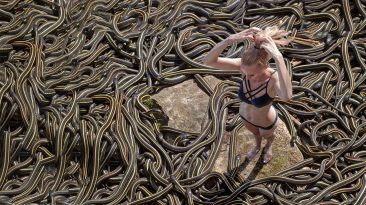All over the world, people are treating bodies of water like they are giant garbage dumps. And experts say that continuing these practices will result in catastrophic damage to marine life. But what if we’re just not dumping our trash in water that’s deep enough? What if we dumped our trash down in the deepest part of the ocean? Would the immense pressure down there act as a natural trash compactor? How would all that garbage affect the rest of the ocean?
The Mariana Trench is a vast crack in the Earth, deep at the bottom of the Pacific Ocean. Its deepest point is 11 km (6.8 mi) below sea level. The trench is so big that we could theoretically keep stuffing our trash away there for thousands of years. But only three people have ever made it down to the bottom of the trench. So how likely is it that we could get all the world’s trash down there?
Before we dive too deeply into that, let’s find out how much trash we’re talking about. We produce over 2 billion tons of waste every year. And this is expected to increase to almost 3.5 billion tons by 2050. To put it in perspective, that would be about 1,000 times the volume of the Great Pyramid of Giza. To get rid of the waste, we’ve tried things like throwing it into landfills, and burning it up, but neither of those are working out too well. Both landfills and garbage incinerators release toxins that leach into our soil, air, and groundwater, becoming long-term hazards to our environment, and to our safety.
So it’s time to get creative, and try something new. And that brings us to the Mariana Trench. The trench is so vast that it could hold as much as 970,000 billion tons of waste. That’s enough space to allow us to keep stuffing away the world’s trash for thousands of years. The pressure in the trench is also very high. It’s comparable to the pressure that a tower of 2,000 elephants would exert on a surface smaller than one square meter (11 square ft)!
We could use that pressure to our advantage, as it will compress any waste that we put down there. It would be like when a car crusher compresses a car. This would allow us to put even more trash into the trench! Now, all we have to do is figure out a way to get our waste down there.
One option would be to transport the waste down there using a submarine, but that would be very expensive. For comparison, the submarine used to bring filmmaker James Cameron to the bottom of the trench cost USD $10 million, and only one person could fit in that sub. A better solution would be to use a pipe system, similar to the waste pipes that some construction scaffolds use.
The garbage pipes would have to withstand the high pressure of the ocean floor. And their paths would have to be carefully planned out to account for different depths along the trench. But even if we could get all our trash down there, would it be a good solution to our waste problem? It doesn’t matter what part of the ocean we dump our trash into. It’s still going to cause pollution.
Waste is filled with dangerous metals, chemicals, and microplastics that can leak out into its surroundings. These chemicals and microplastics could then be passed on to us humans through the fish we eat, the water we drink, and even the air we breathe. So, rather than finding new places to dump our garbage, maybe we should focus on trying to produce less of it instead. The zero-waste movement is already picking up speed. Can you imagine how quickly our planet would recover if we produced no waste at all?
Sources
- “About The Mariana Trench – DEEPSEA CHALLENGE Expedition“. 2012. DEEPSEA CHALLENGE.
- “The World Counts“. 2020. Theworldcounts.Com.
- “Bloomberg – Are You A Robot?“. 2020. Bloomberg.Com.
- “New UN Report Finds Marine Debris Harming More Than 800 Species, Costing Countries Millions“. 2016. UN News.
- “Pressure At The Deepest Point In The Oceans – The Physics Factbook“. 2020. Hypertextbook.Com.
- “Deepwater Pipelines Taking The Challenge To New Depths“. 2009. Offshore.
- “Explorer Reaches Bottom Of The Mariana Trench, Breaks Record For Deepest Dive Ever“.Saplakoglu, Yasemin. 2019. Livescience.Com.




























Oh wow!!! This is so interesting, how it acts like a natural compactor, and crushes it. But I think that it would be a better idea to produce less trash, than dump it.
This is literally the worst idea I’ve ever heard. I believe it is critical we find a way to get rid of, disintegrate, and repurpose trash rather than just dump it somewhere else. This is not a permanent solution and will definitely give rise to new and bigger problems.